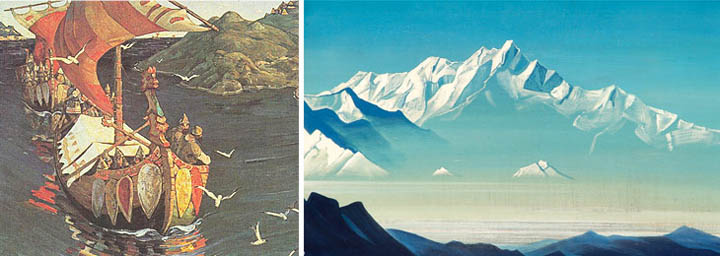ARTISTS
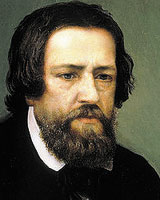 Alexander Ivanov (1806-1858) – the artist, thinker and theorist – was born in St. Petersburg. His father Andrey Ivanov, was a professor of historical painting. In 1817 Alexander joined the Academy as an “external student” and – unlike the regular students – continued to live at home.
Alexander Ivanov (1806-1858) – the artist, thinker and theorist – was born in St. Petersburg. His father Andrey Ivanov, was a professor of historical painting. In 1817 Alexander joined the Academy as an “external student” and – unlike the regular students – continued to live at home.
The artist completed his student years with a program work on a Biblical theme: Joseph Interprets the Prisoners’ Dreams (1827). Though Ivanov was awarded a first-class gold medal, the ideas which were clearly expressed in the picture – of man’s defenselessness in the face of tyranny, and the flouting of the concepts of justice and lawfulness – caused dissatisfaction among the Academy’s ruling circles. Alexander Ivanov had to produce a new diploma work in order to obtain the right to go to Italy. In the spring of 1830, having completed a small work entitled Bellerophon Sets Out on a Campaign against Chimaera, Ivanov finally was given an opportunity to travel to Italy at the expense of the Society for the Encouragement of Artists.
From the very start of his stay in Italy Ivanov was constantly on the look out for a theme that might totally engross him. He conceived the idea of a large-scale painting about the appearance of the Messiah.
Over a period of twenty years Alexander Ivanov worked on his huge canvas Christ’s Appearance to the People (1837-1857). The painting of this enormous canvas (40 sq. m.) was preceded by extensive preparatory work. Ivanov made more than 600 preliminary etudes, sketches and drawings. These etudes proved to be a wonderful school in realism for the following generation of artists. Particularly noteworthy are his famous landscapes, in which he succeeded in conveying the link between his models and the landscape: Boys at the Bay of Naples, Seven Boys in Coloured Clothing and Drapery, Etude of Nude Boy. These works are considered masterpieces of Russian and world landscape painting.
In the spring of 1858 Alexander Ivanov returned to St. Petersburg. His masterpiece Christ’s Appearance to the People and numerous etudes for it, exhibited in the halls of the Academy of Arts, drew a cold reception. The artist was the butt of much bitter and unjust criticism. But Ivanov did find some worthy friends in his homeland – the art critic Vladimir Stasov and Nikolay Chernyshevsky, with whom he shared his plans, discussed the possibilities of starting a new Russian artistic school and of setting up educational institutions for young artists, and dreamed of travelling over Russia and painting new national historical canvases.
Alexander Ivanov’s life came to an abrupt end in July 1858, when he died of cholera.
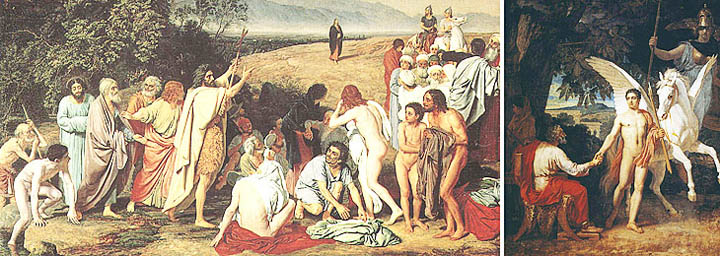
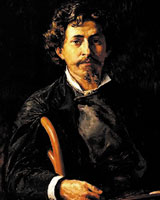 Ilya Repin (1844-1930) was born in the town of Chuguev, Kharkov province. In his childhood and youth the future artist suffered privations and painted icons and portraits to earn money. He had his first lessons in drawing at the school of topography.
Ilya Repin (1844-1930) was born in the town of Chuguev, Kharkov province. In his childhood and youth the future artist suffered privations and painted icons and portraits to earn money. He had his first lessons in drawing at the school of topography.
In 1863 Repin decided to take the risk and go to St. Petersburg. At the Stock Exchange Drawing School he met Ivan Kramskoy, who immediately noticed his outstanding talent and became his friend and mentor for many years. In 1864 Repin entered the St. Petersburg Academy of Arts and in 1871 he graduated brilliantly with the painting The Raising of Jairus’s Daughter.
In 1873 Repin painted his best-known work The Volga Boatmen. His realism caused a sensation in the art world of the day. Repin’s name was quickly famous. He became generally acknowledged as an artist of truly immense range. He was awarded a grant to study abroad, mainly in Paris.
On his return to Russia in 1876 Repin really got into his stride. He joined the society of Peredvizhniki and in the eighties became its leading artist, the author of historical and genre compositions and a brilliant portraitist. By the end of the century Repin had gained wide public recognition. A personal exhibition of his works was opened, and after the reform of the Academy of Arts he was made a professor.
The artist spent the last thirty years of his life in Kuokkala (now Repino) where he had a refurbished house with a studio, called Penates. He is buried there and his former house has been turned into a museum, with some of his paintings on display. Most of his works, however, are either in the Tretyakov Gallery in Moscow or in the Russian Museum, St. Petersburg. These include: The Zaporozhets Cossacks Writing a Letter to the Turkish Sultan (1880-1891), The Meeting of the State Council (1901-1903) and numerous portraits.
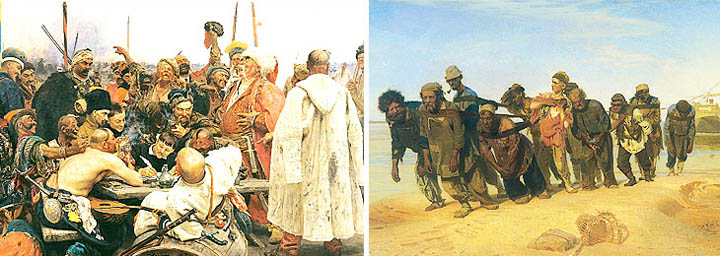
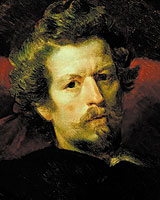 Karl Bryullov (1799-1852) was a son of academician of ornamental sculpture Pavel Bryullov. He was born in St. Petersburg and at the age of nine became a student at the Academy of Arts, where his older brothers were already enrolled.
Karl Bryullov (1799-1852) was a son of academician of ornamental sculpture Pavel Bryullov. He was born in St. Petersburg and at the age of nine became a student at the Academy of Arts, where his older brothers were already enrolled.
Many leading artists of the time noticed Karl Bryullov’s rare abilities at an early age. According to one of his friends he left the academy with “handfuls” of awards and all the minor and major silver medals. His teachers were not at all pleased, however, by those of the young artist’s works which violated the strict academic rules.
In 1822 Karl and his brother Alexander set off for Italy as beneficiaries of the newly founded Society for the Encouragement of the Artists. Karl Bryullov’s work in Rome commenced with a study of Raphael’s Vatican frescos and antique sculpture. What appealed to him in the work of the great painters of the past – Raphael, Titian, Rembrandt – was their virisimilitude.
Notwithstanding the Society’s warnings, Karl Bryullov applied himself avidly to genre painting. He saw beauty in the profusion of sensations in life, in the immediacy of human feelings, in simple, everyday things. His view of the tasks of art manifested itself clearly in Italian Morning (1824), Girl Picking Grapes in the Environs of Naples (1827) and Italian Midday (1827).
The artist’s delight in the beauty of nature and in the free manifestation of human emotions roused his interest in the small chamber portrait and in the picture portrait. His famous picture portrait A Lady on Horseback (1832) received a particularly warm reception.
Bryullov’s striking talent, good education and independent outlook attracted the attention of his contemporaries. It is not surprising that his studio on the Via Corso in Rome was a popular meeting place.
The artist’s most important work was The Last Day of Pompeii (1833) which dealt with the tragedy of Roman city that perished when Vesuvius erupted (first century A.D.). Bryullov took six years to complete this canvas, having studied documents relating to the destruction of Pompeii, Pliny’s letters to Tacitus and other historical and archeological materials, and also having visited the excavations at Herculaneum and Pompeii.
In the autumn of 1833 Karl Bryullov opened the doors of his studio, and soon The Last Day of Pompeii began its triumphal tour of exhibitions all over Europe, from Rome and Milan to Paris and St. Petersburg. Its success was enormous. Bryullov was elected honorary member of the Academies of Milan, Bologna, Florence and Parma. In Paris he was awarded a gold medal. The painting was greeted ecstatically by progressive circles in Russia.
In May, 1836 Karl Bryullov returned to St. Petersburg to take up a post as professor at the Academy of Arts. His life in St. Petersburg was not easy or independent. His professorship at the Academy degenerated into an official “service”, always under the eye of the tsarist court. But his friendship with Alexander Pushkin, Vasiliy Zhukovsky, Ivan Krylov and Mikhail Glinka, and his acquaintanceship with Nikolay Gogol, Vissarion Belinsky, Mikhail Lermontov, Evgeniy Baratynsky and Alexander Dargomyzhsky helped him on to new successes.
The portrait gallery of his contemporaries which Bryullov produced in St. Petersburg (he painted about eighty portraits) is the most precious part of his legacy. Self-Portrait (1848), painted when he was already ill, is a kind of autobiography of the artist.
In the spring of 1849 Karl Bryullov went abroad for the sake of his health. He died on June 23, 1852 in the village of Marciano near Rome.
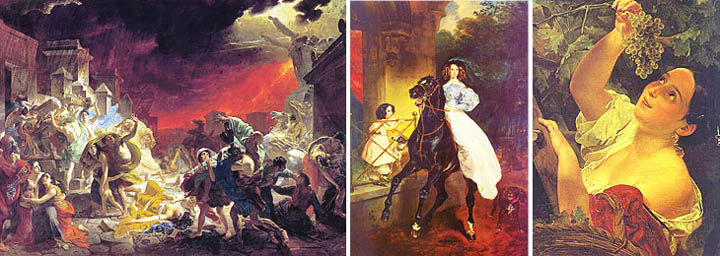
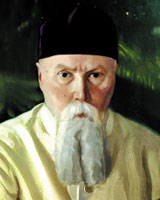 Nikolay Roerich (1874-1947), an outstanding artist, scholar and public figure, was born in St. Petersburg. His father, who owned a notary office, was a highly cultured man with a wide range of interests, and many leading scholars of the day were attached to the Roerich household.
Nikolay Roerich (1874-1947), an outstanding artist, scholar and public figure, was born in St. Petersburg. His father, who owned a notary office, was a highly cultured man with a wide range of interests, and many leading scholars of the day were attached to the Roerich household.
From childhood the future artist loved reading historical books and listening to ancient legends. He developed a rich imagination and a keen interest in ancient Rus. During his years at the gymnasium he took part in archeological excavations, and it was also at this time that his talent for drawing became apparent.
On leaving the gymnasium in 1893, Roerich became a student both at the Academy of Arts and in the Law Faculty of the University. His interest in the mysteries of the past, however, continued to grow, and he also attended lectures in the Department of History. As a member of the Russian Archeological Society, he spent the summer months on excavations.
In 1895, after meeting Vladimir Stasov, who was at that time in charge of the art section of the Public Library, Roerich began a serious study of ancient books, manuscripts and deeds.
Roerich’s teacher, Kuinji, played an important role in shaping the young artist’s talent. In Kuinji’s studio Roerich began to paint landscapes from nature and also completed his first historical works. In 1897 he and Kuinji’s other pupils left the Academy as a sign of protest at the dismissal of their beloved teacher. He continued working on a series of paintings based on the life of the ancient Slavs, which he entitled The Beginning of Rus; the Slavs. Characteristic of Roerich’s early painting are his rich fantasy, his emotional perception of ancient times and his ability to convey the special flavour of those times.
In the summer of 1903 and 1904 Roerich and his wife made a tour of ancient Russian towns, studying their architecture, painting, applied arts, folklore and traditional dances. This led to a series of 90 picturesque canvases portraying monuments of old Russian architecture.
In 1906 Roerich began work on an unusual series of paintings about human prehistory. In this series Roerich gave symbolic expression to his philosophical outlook, which was linked to the ideas of the Enlightenment. He contrasts contemporary society with a past idyll, where people were motivated by goodness and love, and lived in harmony with nature.
In the pre-war years, works appeared with fantastic subject-matter, intense expressiveness and generalized artistic language. Of enormous interest are the sets which Roerich designed for the theater. Roerich also worked in the genre of monumental art, making sketches for the decoration of secular buildings and churches.
He was sympathetic towards the revolution and joined the Arts Commission set up in March 1917. In May 1917, owing to a serious lung disease, Roerich went to the Karelian Isthmus, and in the spring of the following year, when the interventionists attacked Russia, he found himself abroad.
In 1918 Roerich traveled in Finland, Norway, Denmark and England with an exhibition of his works, and in 1920 he went to America, where his work was particularly well received.
In 1923 the artist left America and went for France via Italy and Switzerland. From France he sailed East, having made up his mind to realize a long-cherished dream – to make a tour of India and Central Asia. This unusual expedition lasted for 5 years.
In 1928, for the purpose of sorting out the collected material, he set up the Himalayan Institute for Scientific Research in the Kulu Valley (Western Himalayas). In 1930 Roerich and his family settled permanently in the Kulu Valley, where he was visited by famous Indian artists and politicians.
The works which Roerich painted in India are extremely diverse in character. His principal works during the last twenty years of his life, however, were landscapes, which were as a rule suffused with a deep philosophical content. In them Roerich glorified the majesty and eternal beauty of nature. He painted over six hundred pictures of the Eastern Himalayas, which together constitute a beautiful epic poem on canvas.
The artist died in India, and a monument was erected on the spot were he was cremated in the Kulu Valley with the inscription: Here, on December 13, 1947, was cremated the body of Nikolay Roerich, the great Russian friend of India.
Museum-Institute of the Roerich Family in St. Petersburg
Memorial exhibition dedicated to the Roerich family.
18-ya Liniya, 1/41
Tel: 323-08-85
We-Su 11-17; M. Vasileostrovskaya
